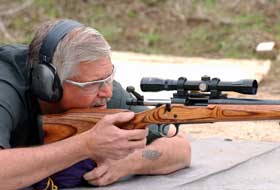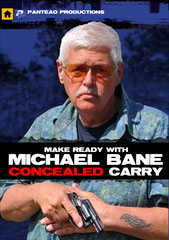...is, I suppose, not to shop! In between food and long, long bouts of sleeping, we did manage to get to the hardware store to buy a replacement shelf and the yarn store for my Sweetie, the World's Fastest Knitter, to pick out an autumn project. While she was sifting through yarn, one of the store owners took the time to explain and show how a spinning wheel works, which turned out to be pretty fascinating...I've always imagined tat wool became yarn through some process that involved a wand and mumbled words of incantation. Next time my Sweeter buys yarn we're going to go for "Instructing Stupid Boyfriend on Basic Loom."
Some catch-up stuff from Taurus and Rossi...remember this year's SHOT SHOW and the briefly shown Trail Judge. a .410 mare's leg style pistol-ly thing based on the new Rossi Rio Grande lever gun platform, which features a side-eject like a Marlin? My cherubs and seraphim told me that there were some big potential issues on the gun's importability, since it skated along the edges of ATF's definition of a short-barreled shotgun (SBS). In late March Rossi confirmed to DRTV that a .410 version of the Trail Judge would not be produced.
Good news (especially for us "exotic" gun fans)...a .410 and .45 Colt version of the Trail Judge has, I was told in Brazil, met ATF muster and will be imported. I was told the new gun would run both .410s and .45s mixed in the mag tube...the version I handled had a screw-in choke as well as the rifled barrel.
No doubt one of these babies will be coming to the Secret Hidden Bunker ASAP. And, no, it's not "tactical!"
I think the Rio Grande versions in 45/70 and the one in .410 have potential good-sized markets in the United States. We've done SHOOTING GALLERY episodes on using a lever gun for self-defense and we made a big point then of the 45/70 versions as pure-D stompers. We used Marlns,ch have been in short supply lately, but since those episodes we've seen the return of the Winchester 1886 in several flavors and now the Rossi. I keep a lever gun around the house — a Marlin .44 Magnum — but a 45/70 would be a welcome upgrade. Up here at the Secret Hidden Bunker, I love the various larger-teethed fauna, but if I have to shoot one I'd plan to shoot it a lot.
I am apparently one of the few people on earth (except of course for the huge number of actual paying customer for such guns) who thinks the .410 is something more than a .22 Short in a larger package. Years ago we used to recommend the .410 (usually in the pump version) as a self-defense tool in a couple of situations — urban locations, especially cardboard-walled apartments, where penetration absolutely had to be controlled, or for people who had legitimate issuers with recoil (injuries, age, fill in the blank). Back then we were of the opinion that various and sundry miscreants would not be willing to stand in front of a hailstorm of pellets or buckshot, even if that hailstorm was coming from a lowly .410.
Of course, that was before we had predictive models for "stopping power." Let's see...which model are we on now? Oh yeah, penetration! Which has superseded speed, expansion, cross-sectional area of bullet, and probably a few others I've forgotten. Okay, enough snark...predictive models are indeed useful, but it is important to remember that the map is not the trail.
There is, I believe, a huge psychological element to gunshots...obviously, predictive models can't address such issues. But there's an old saw something to the effect that we tend to measure what we can measure, then because we can measure something we assign that something a greater value than factors harder to measure. I keep coming back to the necessity for multiple shots to guarantee the aggressor stops aggressing.
And I come back to the words of the great Walt Rauch, an occasional commentator here and a person who has forgotten more about these topics than I will ever know: "No one wants to leak."
Saturday, November 26, 2011
Subscribe to:
Post Comments (Atom)







13 comments:
Or to quote another Walt..."Fantasy and reality often overlap." —Walt Disney
Michael,
I'm sure you are familiar with Dr. Martin Fackler?
He said similar things years ago in his papers. When he was debunking the pseudo science published by Sanow, et al, he talked about how multiple shots were needed.
George,
How is accurately documenting the real world performance of bullets considered "pseudo science"?
Compare that reality-based method with Fackler's own resume (from his wikipedia page):
"He hypothesized that wound depth was much more important than previously thought, and recommended ammunition that could send a bullet at least twelve inches into his ballistic gelatin."
"He was the first researcher to demonstrate that fragmentation was the most effective means of inflicting wounds in a modern military rifle round. He asserted that yawing and cavitation do not typically cause severe tissue trauma. Or, that the "permanent wound cavity" or actual damage caused by a projectile is the primary "stopping power" mechanism and that the "temporary wound cavity" or shock wave produce by the projectile is at best a secondary mechanism, if not irrelevant."
Emphasis mine. Those are assertions & claims that Fackler was peddling, not proven facts.
Theories are nice. Socialism works great, in theory.
But we live in the real world.
Article about different ways of weighing bullet performance here:
http://www.backwoodshome.com/articles2/ayoob93.html
Browning has a 410 BPS riot gun listed on their site as a 2011 SHOT Show special. I haven't actually seen one offered for sale, so were they ever produced?
I have a Winchester 9410 lever (an early one with the crossbolt safety). Neat little guns.
@Gunnutmegger,
I'm sorry I hurt your feelings.
It is not science when I extrapolate from one, unique, incident a certain type of round will produce a one-shot stop X percent of the time. I have read Sanow's work several times and that is what he attempted to do. It was done with good intentions, but it was pseudo science and it lead to a misunderstanding.
As for Fackler he did attempt controlled experiments to come up with his findings. If you have access to a local university's medical library, look up the papers he wrote. I think he is the one who developed the ballistic gelatin test that is used today.
You are making a point about what SOMEONE POSTED ON WIKIPEDIA, which proves what? Please read his research, then come back to argue with me. And I'll give you a head start:
http://www.firearmstactical.com/pdf/fbi-hwfe.pdf
This report was written by the FBI and is based upon Fackler's research at that time. Use the footnotes to find Fackler's research and I think you will be enlightened.
I wouldn't take a new Marlin for free. Not until I have ironclad assurance that Remington has fixed the inexcusable QC problems.
George,
I don't understand your reference to feelings.
But clearly you are not telling the truth in your commentaries. Example:
"It is not science when I extrapolate from one, unique, incident a certain type of round will produce a one-shot stop X percent of the time. I have read Sanow's work several times and that is what he attempted to do."
One incident? Try thousands of incidents. How can someone read Marshall & Sanow's books "several times" and miss that?
I remember a line from a W.C. Fields movie, where he said he was reading the bible, looking for loopholes. I can understand how someone who is desperate to believe that non-expanding bullets are effective on humans would try to block out all of the documentation that shows them to be the least effective bullet designs available, but that is the way it is.
The conclusions in the book were not about specific bullet designs, and they were expressly not "predictive" (which you would know if you had read either of Marshall & Sanow's books). The authors assembled an accurate tabulation of existing data. The actual results of shootings shows that expanding bullets of any type are more effective at stopping people than non-expanding designs. Not just for one caliber, but for all of them.
I have read Fackler's work, and have had pdfs of his work on my hard drive for years (I still have dead tree copies in a box somewhere, from the pre-computer age). You seem to be misinterpreting Fackler's writings. All of his work was theoretical, and conducted under very controlled conditions, conditions that do not reflect the use of actual bullets on actual human beings. But, if I am ever attacked by a block of gelatin, I will be sure to take Fackler's advice.
Fackler used 10% gelatin, the FBI preferred 20%. But, just because some law enforcement agency writes a report does not mean that report is accurate or unbiased.
And, if you bothered to read the old article you linked to, you would have found this on page 4:
"Projectiles incapacitate by damaging or destroying the central nervous system, or by causing lethal blood loss. To the extent the wound components cause or increase the effects of these two mechanisms, the likelihood of incapacitation increases."
Last time I checked, there isn't much of the central nervous system's organs in the torso of a human. Unless you count the brain of a person who has their head up their own ass about the reality of bullet performance.
I am not convinced that you can cogently explain what Fackler's research showed and what conclusions he drew. I see you typing things, but they don't seem to be direct quotes of Fackler's work, but rather claims about what his work showed.
It's obvious that you have some rigid preconceptions about bullet performance that you are determined to cling to. I hold out no hope that you wll let any pesky facts into your noggin.
But the rest of the people who read this need to be warned that relying on a guy who shot Jello as his only research tool is not the last word in what bullets to use.
I went to an 8 stage IDPA night shoot match on Friday...well...night. I got to talking to one of the more tactically oriented shooters. He said there was Indiana cop (a state trooper maybe?) who did all sorts of research on past police involved shootings. His conclusion was pistols were anemic at best. If you're going to a gunfight, bring a shotgun or a rifle.
I think the real trick is to go Cyber Monday shopping. That link is for The Sportsman's Guide's Cyber Monday sale. It's still going on right now. I got a new reel for my boy and some bolts for the next time I take out my crossbow. It's definitely worth checking out while they still have some stuff left.
"I was told the new gun would run both .410s and .45s mixed in the mag tube...the version I handled had a screw-in choke as well as the rifled barrel."
That should make for some "youtube" fodder! What was it Molly Hatchet said about disaster?
@Gunnutbugger
If I didn't hurt your feelings in my first post, my second post evidently sent you over the edge! For this I apologize.
I see you have a blog, which looks good I might add. And we all know that if you have a blog that makes you an expert!
I read Marshall's and Sanow's work, and like I posted earlier, they had good intentions but made the mistake of trying to use anecdotal evidence as a basis for making some predictions about terminal performance of different bullets.
And one odd thing you posted had me puzzled. You implied that I was a "person who has their head up their own ass about the reality of bullet performance." I have to say that was very clever of you. But I would know nothing about having my head up any ass. I will defer to the experts, such as you, who seem to have intimate knowledge and insight about placing your head up the ass of yourself or someone else.
I'm going to raise the white flag here and let you have the win. If this will help heal your bruised ego, I am more than happy to bow out in defeat.
George45,
Accusing me of having "hurt feelings" and altering my name for humorous effect would indicate that, despite your protestations, you are projecting when you claim that I am the one who is upset. LOL
"I read Marshall's and Sanow's work, and like I posted earlier, they had good intentions but made the mistake of trying to use anecdotal evidence as a basis for making some predictions about terminal performance of different bullets."
Laboratory testing only goes so far, and cannot replicate all of the variables of the real world. No intelligent person believes otherwise. (Analogy: picking your next car based on the specs in the brochure without test-driving it.)
Real-world results are very relevant (larger data-set = more relevance) but contain many variables, some of which can be tracked and some which cannot. (Analogy: buying a car based on a fun test-drive, without checking to see what Consumer Reports says about it's reliability).
Using only one of those methods to determine what bullets are most effective is unwise. That appears to be your approach.
Using both methods, to find a bullet design that performs well in the real world as well as in the laboratory, reduces your chances of choosing an ammo that won't perform. But I might be biased because that is what I did.
Hopefully you will never be put into the position of having to use a firearm loaded with underperforming non-expanding ammunition while protecting the patrons of one of America’s largest indoor retail shopping areas.
Post a Comment